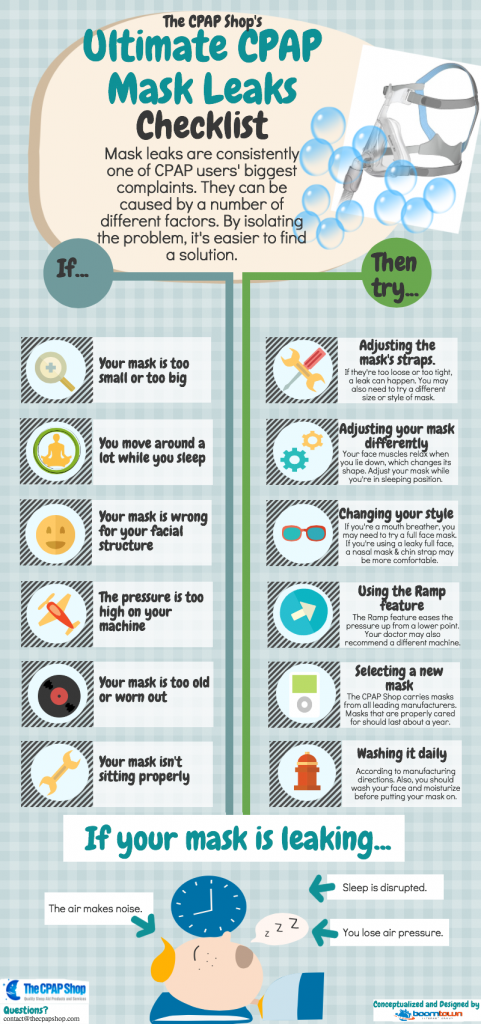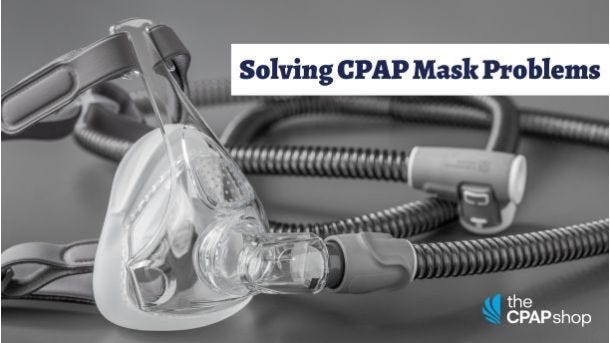Solving CPAP Mask Problems
I Can’t Breathe with CPAP Mask
Sometimes we get calls from CPAP patients using full-face CPAP masks calling in asking what to do about the feeling that they can’t breathe with a CPAP mask.
Like aircraft pilots, CPAP patients can get the sensation of not being able to breathe. This sensation could be caused by several different factors. The following is a short list of causes and their remedies.
1. Positive Pressure is Too High
Check with your physician and insurance provider about getting a Respironics DreamStation or a Resmed AirSense10 Auto CPAP machine with many comfortable breathing features.
2. Arrested Breathing
This can happen to many people. There have been many movies that have shown military pilots that take their masks off. The movie Independence Day has an example. To solve the problem, hold your breath and count to five slowly, then begin breathing normally again.
3. Claustrophobic
Imagine yourself in a boat in the middle of a calm lake fishing with your best friend. Hold your breath and count to five slowly, then begin breathing normally again. If this doesn’t help get a CPAP nasal mask or nasal pillow mask.
Itchy And Dry Nose/Mouth
After numerous tries on various masks CPAP masks, you have finally found a comfortable CPAP mask that fits all the intricacies of your face. This, as most CPAP users are acutely aware, is no small feat. Even though your mask fits comfortably on your face, you may still have a common problem. Users complain about continual dry mouth and/or stuffy nose.
1. Heated Humidifier
A simple and cost-effective solution to this issue is the addition of a heated humidifier to your CPAP machine. Using a heated humidifier will help decrease nasal congestion and stuffiness. Also, this results in a more comfortable CPAP experience and a more rested feeling when you wake up.
Newer-style CPAP machines often come with an integrated heated humidifier. These integrated units are still quite small and considered very travel-friendly. Even older CPAP machines can make use of a universal stand-alone heated humidifier such as the Velocity Heated Humidifier.
ResMed AirSense 10 AutoSet Card-to-Cloud CPAP Machine
• Features a card-to-cloud service that sends data to the cloud for a patient’s doctor to review
Shop Now2. Inspect Cushions Regularly for a Proper Seal
Additionally, an improperly sealed CPAP mask can also produce a dry feeling in the nose and throat. It is vital to inspect your CPAP mask continuously to make sure that the silicone or gel cushion has not broken down. It is important that the cushion is still providing an effective seal. Generally, you should replace these cushions within 3 to 6 months of constant use to maintain efficacy.
Facial Marks And Nose Sores
For the most effective results, CPAP users need to ensure the mask has an effective and comfortable seal around the nose or the nose and mouth. We have spoken to hundreds of patients and found that CPAP users commonly mention facial marks and nose sores as irritants. This issue is generally from users' over-tightening of the mask straps. CPAP masks are designed to produce an effective seal without applying significant amounts of pressure to the face. In fact, if you are over-tightening your mask, it is probably time for a new cushion or complete mask. Nevertheless, a simple but effective solution is to put the mask on while in bed.
1. Put the Mask on While Laying in Bed
While you are lying in bed, place the mask on your face and connect the headgear so the mask is snug but not tight. A CPAP mask is designed to have an evenly distributed seal. Placing the mask on while lying down, allows for a proper fit during sleeping. Make sure that your mask fits snuggly but not loose as this will cause air to escape. If there is too much tension toward the top of the mask, it can cause sores on the nose.
2. Use a Mask with Gel or Inflatable Cushions
While finding a comfortable CPAP mask is ideal, having the proper size mask is crucial to effective CPAP treatment. Many of the new style masks have implemented gel or inflatable type cushions that compensate for movements in any direction. These types of masks allow for an improved seal without needing to over-tighten the mask straps. The Respironics Comfort Gel nasal mask and the Resmed Mirage Activa LT are two excellent examples of this technology. Furthermore, masks such as the Resmed Mirage Micro LT have an adjustable forehead assembly that can easily be modified to suit each user’s profile.
CPAP Pressure Tolerance
Most first-time users experience the unpleasant feeling of CPAP air pressure immediately. The pressure is delivered from the CPAP machine, through a tube, and into the CPAP mask generally at a fixed rate.
1. Use the Pressure Ramp Feature
This sensation, which can be uncomfortable to new users, will be alleviated by using the ramp feature on your CPAP machine. The ramp feature allows the CPAP pressure to gradually increase over a period of time. For example, if your CPAP pressure is 13cm/H20, you may find it more relaxing to have the CPAP pressure start at 4cm/H20 and then “ramp up” over 20 minutes, at which time the CPAP machine will reach its prescribed setting. This is usually accomplished while you are drifting off to sleep so it is less intrusive. Most of the high-end CPAP machines (auto adjusting) have a ramp feature that is automatic and does not require manual adjustments. By using this feature properly, the CPAP user should become accustomed to the prescribed pressure and have less trouble securing their CPAP mask. If problems continue, please consult with your sleep specialist.
The Ultimate Checklist to Fix CPAP Mask Leaks

CPAP mask leaks are without a doubt one of the most troublesome issues one can have with his or her CPAP therapy, and leaks happen to almost every CPAP user at some point or another. Some are lucky enough to find their “perfect fit” mask the first time around, but others struggle for years to find a mask that doesn’t let noisy air out, disturb their partner, and lessen the effectiveness of the CPAP machine.
With this guide, we hope to help people troubleshoot their mask issues and figure out how to solve the problem. We know how annoying those leaks are, and on top of that, they’re not good for your health. (The more air that gets out of the mask, the less that gets into your lungs.)
Maybe your mask is just too old and the straps are worn out, or maybe the mask you bought is just the wrong shape for your bone structure. Whatever the case may be, we are here to help answer your questions and help you figure out how to get your best night’s sleep ever.
CPAP Masks Replacement
Many patients do not understand the importance of replacing CPAP masks and parts on a regular basis. It is important to clean your CPAP mask and tubing. You should replace parts such as cushions, headgear, and tubing on a regular basis. Ignoring the replacement timeline can lead to sleep therapy discomfort, mask leaks, and illness. Eventually, it will also lead to non-compliance. As a whole, it is important to replace a CPAP mask on a yearly basis while other CPAP mask parts should be replaced more frequently.
Replacing CPAP Mask Cushions
Cushions are a particularly important part of all CPAP masks and should be replaced at least every three months. The constant wearing of a mask compresses the cushion. This typically leads to a weaker seal and adversely affects the efficiency of the mask. If the mask does not form a strong seal, it will not do its job properly. This then leads to ineffective sleep therapy treatment. Moreover, the effectiveness of the mask cushion’s seal tends to decrease from oils in the patient’s face. Cleaning certainly should be routine but eventually, it is necessary to replace the cushion. Unfortunately, when cushions lose their efficacy, CPAP users tend to just tighten the mask further. This creates a host of other issues including strap marks, headaches, and teeth and jaw pain.
Replacing CPAP Tubing
While the CPAP tubing is cleanable with the proper supplies, the buildup of germs can still occur even if cleaning is routine. Typically, you should replace CPAP tubing every 6 to 9 months. It is important to remember that you are breathing anything in the CPAP tube directly into the lungs, which can lead to respiratory issues. If you start to feel congested or develop a chest cold, it may be time to change your tubing. In addition, just like with the CPAP mask cushions, the CPAP tubing can break down over time, which hampers its effectiveness.
Replacing CPAP Mask Headgear
The headgear for a CPAP mask should be replaced every 6 months as well. The headgear’s material is neoprene, which stretches to accommodate facial and head structures, it can stretch out. This can also hamper a CPAP mask’s ability to form a strong seal. That’s because CPAP users try to make the CPAP headgear tighter because of an improper fit and poor seal. Again, by making the mask too tight, CPAP patients can suffer from sores on the face where the mask makes contact. It can also cause strap marks, headaches, and even in rare cases, can cause the teeth of the patient to shift.
If Your CPAP Mask is Uncomfortable, Chances are it’s the Wrong Size
CPAP Mask Sizing
A CPAP mask can be too small or too large or have a particular shape that does not match up well with your facial structure. Any of these issues can make the mask uncomfortable and ineffective and the user less willing to continue with therapy. Since faces come in many different shapes and sizes, it is important to choose a CPAP mask that meets your needs and features. Depending on the manufacturer, there are a variety of styles and sizes a customer can select from. To help you find your perfect mask, try out AR MaskFit, a 3D face scanning capability from the comfort of your own home. Based on your face shape and size and other preferences, this advanced technology selects the best CPAP masks for you. Give it a try today!
For example, with the Respironics OptiLife mask, sizes include petite, small, and medium pillows with small and medium CradleCushions, and medium and large pillows with medium, large, and large narrow CradleCushions. The ResMed Activa LT comes in small, medium, large, and large narrow. It also has one specific to women with an extra small available.
People with sleep apnea who are using CPAP therapy already have much to deal with. Changing a routine that has been the same for many years can be difficult. Not to mention wearing a CPAP mask all night long. There is always a period of adjustment for all CPAP users. Having a comfortable and properly fitted CPAP mask makes the transition much less bothersome.
This post was originally published on June 7, 2010 and updated on August 29, 2023.





